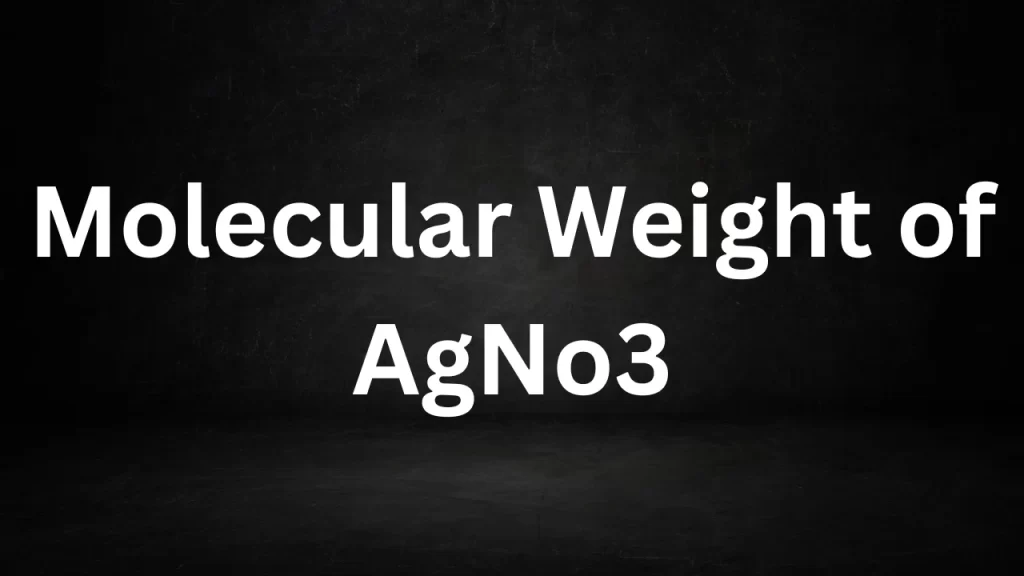Tag: molecular weight agno3
Molecular Weight Of Silver
Molecular Weight Of Silver: Silver is a fascinating element that has captured human interest for thousands of years due to its lustrous appearance and valuable properties. Whether it’s used for making jewelry, coins, or in various industrial applications, silver’s molecular weight plays a crucial role in understanding its behavior and applications.
In this article, we will delve into the concept of molecular weight, explore how it is calculated for silver, and discuss its significance in different contexts.

Molecular Weight Of Silver
What is Molecular Weight?
Molecular weight, also known as mole mass or molar mass, is a fundamental concept in chemistry. It represents the mass of a molecule, compound, or element in atomic mass units (amu). Molecular weight is the sum of the atomic weights of all the atoms in a molecule. It is a crucial parameter in various chemical calculations, including stoichiometry, molarity, and the determination of reaction yields.
The Atomic Structure of Silver
To understand the mole weight of silver, we must first examine its atomic structure. Silver has an atomic number of 47, meaning it has 47 electrons and 47 protons in its nucleus. The most common isotope of silver is Ag-107, which has 60 neutrons. Silver also has another stable isotope, Ag-109, which has 62 neutrons.
Calculating the Molecular Weight of Silver
To calculate the mole weight of silver, we consider its most abundant isotope, Ag-107. The mole weight of silver is calculated by summing the atomic weights of all its constituent atoms. Here’s the breakdown:
Atomic weight of silver (Ag): Approximately 107.8682 amu
Since a silver atom is monatomic, its mole weight is the same as its atomic weight, which is approximately 107.8682 amu.
Significance of Molecular Weight in Silver
- Chemical Reactions: Molecular weight is crucial in stoichiometry, the study of reactants and products in chemical reactions. It helps determine the ratio in which substances react, which is essential for predicting the outcome of chemical reactions involving silver.
- Molarity Calculations: Molecular weight is used to calculate the molarity of a silver-containing solution. Molarity is a measure of the concentration of a solute in a solution, and knowing the mole weight is vital for these calculations.
- Industrial Applications: In various industrial applications, such as electronics and photography, the precise mole weight of silver is essential to ensure the quality and consistency of products.
- Precious Metal Valuation: Molecular weight plays a role in determining the value of silver, especially in the context of precious metal trading. The price of silver is often quoted per troy ounce, and its mole weight is used to convert between weight and monetary value.
Conclusion
Understanding the mole weight of silver is fundamental to both the field of chemistry and its various applications. It provides essential information for chemical calculations, molarity determinations, and plays a significant role in the valuation of this precious metal. As we continue to explore the properties and applications of silver, the mole weight remains a critical parameter that aids our understanding of its behavior and utility in various industries.
Read More
- Molecular Mass Of KCl
- Molecular Mass Of Fe
- Molecular Weight Of H2
- Molar Mass Of Methane
- Molecular Mass Of Sodium Hydroxide
Frequently Askked Questions (FAQs) On Molecular Weight Of Silver
1. What is the molecular weight of silver?
The mole weight of silver is approximately 107.8682 atomic mass units (amu). This value is calculated based on the atomic weight of the most abundant stable isotope of silver, Ag-107.
2. Why is the molecular weight of silver important?
The mole weight of silver is important in various chemical calculations, including stoichiometry, molarity calculations, and determining the value of silver in industrial and precious metal contexts. It helps scientists and chemists understand how silver atoms combine and react in chemical processes.
3. How is the molecular weight of silver calculated?
The mole weight of silver is calculated by summing the atomic weights of all the atoms in a silver molecule. Since silver is a monatomic element, its mole weight is the same as its atomic weight, which is approximately 107.8682 amu.
4. Are there different isotopes of silver, and do they affect its molecular weight?
Yes, silver has two stable isotopes: Ag-107 and Ag-109. Ag-107 is the most abundant isotope, while Ag-109 is less common. However, the mole weight is primarily based on the most abundant isotope, Ag-107, which has 60 neutrons. Ag-109, with 62 neutrons, is less abundant and does not significantly affect the molecular weight of silver.
5. What is the significance of knowing the molecular weight of silver in industrial applications?
In industrial applications, such as electronics, photography, and metallurgy, knowing the mole weight of silver is crucial for ensuring product quality and consistency. It helps manufacturers accurately measure and mix silver-based materials, which is essential for achieving desired properties and performance.
Molecular Weight of AgNO3
=Molecular Weight of AgNo3: In the realm of chemistry, molecular weight (also known as mole mass or molar mass) plays a pivotal role in understanding the properties and behavior of substances.
mole weight refers to the mass of a molecule or a compound, expressed in atomic mass units (amu) or grams per mole (g/mol). To grasp the significance of mole weight, let’s delve into the specific case of AgNO3, which is silver nitrate, and explore its mole weight in detail.

The Composition of AgNO3
Silver nitrate, represented by the chemical formula AgNO3, is a well-known inorganic compound. It is composed of three elements: silver (Ag), nitrogen (N), and oxygen (O). To determine the molecular weight of AgNO3, we need to calculate the sum of the atomic weights of these constituent elements.
Atomic Weights of the Constituent Elements:
- Silver (Ag) has an atomic weight of approximately 107.8682 g/mol.
- Nitrogen (N) has an atomic weight of roughly 14.0067 g/mol.
- Oxygen (O) has an atomic weight of approximately 15.9994 g/mol.
Calculating the Molecular Weight of AgNO3
Now, let’s calculate the molecular weight of AgNO3 by adding the atomic weights of its constituent elements:
mole Weight of AgNO3 = Atomic Weight of Ag + Atomic Weight of N + (3 * Atomic Weight of O)
mole Weight of AgNO3 = 107.8682 g/mol + 14.0067 g/mol + (3 * 15.9994 g/mol)
The mole Weight of AgNO3 ≈ 169.8735 g/mol
Therefore, the mole weight of silver nitrate (AgNO3) is approximately 169.8735 grams per mole (g/mol).
Significance of AgNO3 Molecular Weight
Understanding the mole weight of AgNO3 is crucial for various scientific and practical applications:
- Chemical Reactions: Chemists use the mole weight of AgNO3 to determine the quantities of reactants and products in chemical reactions. This is essential for stoichiometry, ensuring precise measurements and balanced equations.
- Laboratory Work: In laboratories, AgNO3 is frequently used in experiments, and its mole weight helps researchers make accurate preparations and dilutions.
- Pharmaceuticals: Silver nitrate has antimicrobial properties and is utilized in medical applications. Its molecular weight is significant in drug formulation and dosage calculations.
- Photography: Silver nitrate has been employed in traditional photography for its light-sensitive properties. Knowledge of its molecular weight aids in photographic chemical processes.
- Analytical Chemistry: In analytical chemistry, the mole weight of AgNO3 is used in titration and quantitative analysis methods.
Conclusion
The mole weight of AgNO3 (silver nitrate) is approximately 169.8735 g/mol. This value is fundamental in chemistry and various industries, guiding precise measurements, chemical reactions, and applications where silver nitrate is a key component. Understanding the molecular weight of compounds is an essential aspect of chemical science, enabling scientists and researchers to work effectively with substances in their experiments and applications.
Read More
- Molecular Weight Of CU
- Molecular Weight Of S
- Molecular Weight Of Toluene
- Molecular Weight Of HNO3
- Molecular Mass Of Phosphorus
Frequently Asked Questions (FAQs) on Molecular Weight of AgNo3
1. What is the molecular weight of AgNO3 (Silver Nitrate)?
The mole weight of AgNO3, also known as Silver Nitrate, is approximately 169.8735 grams per mole (g/mol). This value represents the total mass of one mole of Silver Nitrate molecules.
2. What is the method for determining the molecular weight of AgNO3?
To calculate the mole weight of AgNO3, you sum the atomic weights of all the constituent atoms in the compound: one silver (Ag) atom, one nitrogen (N) atom, and three oxygen (O) atoms.
3. Why is knowing the molecular weight of AgNO3 important in chemistry?
Understanding the mole weight of AgNO3 is essential in chemistry for various purposes, including calculating the amount of substance needed in chemical reactions, determining molar concentrations, and performing stoichiometric calculations.
4. What is the significance of the molecular weight of AgNO3 in laboratory experiments?
In laboratory experiments, the molecular weight of AgNO3 is of utmost importance, ensuring precise preparation of solutions, exact calculation of reactant quantities, and the meticulous execution of chemical reactions.
5. How can I use the molecular weight of AgNO3 in stoichiometry?
In stoichiometry, you can use the mole weight of AgNO3 to balance chemical equations and calculate the amount of AgNO3 required to react with other substances in a precise manner.